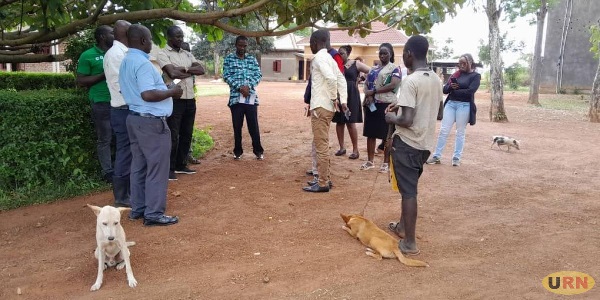
Tororo, Uganda | THE INDEPENDENT | A severe shortage of rabies vaccines has hit government health facilities in Eastern Uganda amidst a surge in the number of people bitten by suspected rabid animals. A survey conducted in Tororo, Busia, and Namayingo districts revealed significant shortages of rabies vaccines, leaving many victims stranded at home or seeking help from traditional healers.
Treatment for rabies is available at a few government health facilities, including Tororo Government Hospital, Rubongi Military Hospital, Mulanda and Mukujju Health Center IVs in Tororo, Masafu General Hospital in Busia, and Buyinja Health Sub-District in Namayingo. However, these facilities have nearly run out of stock. For instance, records at Masafu General Hospital in Busia show that the facility receives only 20 doses of rabies vaccines quarterly, insufficient to meet the growing demand.
Rabies is a vaccine-preventable viral disease spread through saliva from infected animals via bites, scratches, or licks to open wounds. It is almost always fatal once symptoms develop. Victims usually show signs of the disease within 1-3 months of being bitten and die within 7-10 days after symptoms appear. Wild carnivores, such as foxes, jackals, and wild dogs, are reservoirs for rabies and can transmit it to domestic dogs.
Symptoms in humans include headache, fear of water, difficulty swallowing, and anxiety. In animals, signs include aggressiveness, excessive salivation, and difficulty swallowing. Rabies is a significant threat in Uganda, where a rabies vaccine costs between 40,000-100,000 UGX in private clinics, making it unaffordable for many.
Tororo is a hotspot for rabies, with over five people bitten by suspected rabid dogs monthly. Maya Collins, a father of five from Namayuge, Buswale Sub-County, Namayingo District, was bitten and infected with rabies in May 2024.
He spent 180,000 UGX for one dose of the vaccine and is uncertain about his future. Stephen Mangeni, from Sikuda Sub-County in Busia, lost his 20-year-old brother to rabies after failing to get a vaccine at Masafu General Hospital. Akello Hellen, from Tororo Municipality, tested positive for rabies and spent 345,000 UGX on treatment at a private hospital.

Timothy Owor, a piggery farmer from Rubongi Sub-County in Tororo, was bitten by a rabid dog in July 2024 and applied engine oil on the wound as first aid due to a lack of knowledge. Teddy Adong, a 62-year-old woman from Tororo Municipality, was bitten by a wild dog in July 2024 and is currently in pain with an untreated wound.
Veterinary epidemiologist Sonja Hartnack, working with Makerere University, emphasizes that dog bites cause over 95% of rabies cases. She advocates for vaccinating dogs to prevent transmission and reduce suffering and healthcare costs.
Dr. Juuko Ndawula, a consultant for herbal therapy, warns against visiting traditional healers for rabies treatment, as it is ineffective. Dr. Pakasi Daniel Nalapa, the Tororo District Veterinary Officer, highlights challenges such as lack of facilitation for pet vaccinations and community reluctance. He recommends massive community sensitization and enforcement of vaccination laws.
Patrick Omitta, the Tororo District Health Inspector, confirms the inadequate availability of rabies vaccines and emphasizes the need for affirmative action. Dr. Okoth Obbo, the Tororo District Health Officer, suggests sensitizing school children about rabies and its dangers. Mary Evelyn Aool, the Natural Officer in Tororo, attributes the influx of wild animals to environmental degradation and urges the public to conserve the environment.
The rabies vaccine shortage in Eastern Uganda, coupled with rising animal bites, poses a significant health threat. Coordinated efforts from the government, health officials, and communities are essential to address the shortage, enhance awareness, and promote preventive measures.
****
URN
 The Independent Uganda: You get the Truth we Pay the Price
The Independent Uganda: You get the Truth we Pay the Price



